From ICISWiki
GRIMS main >
GRIMS functionality >
Seed Acquisition
Previous Next
Entering Passport Information
Overview
User interface form
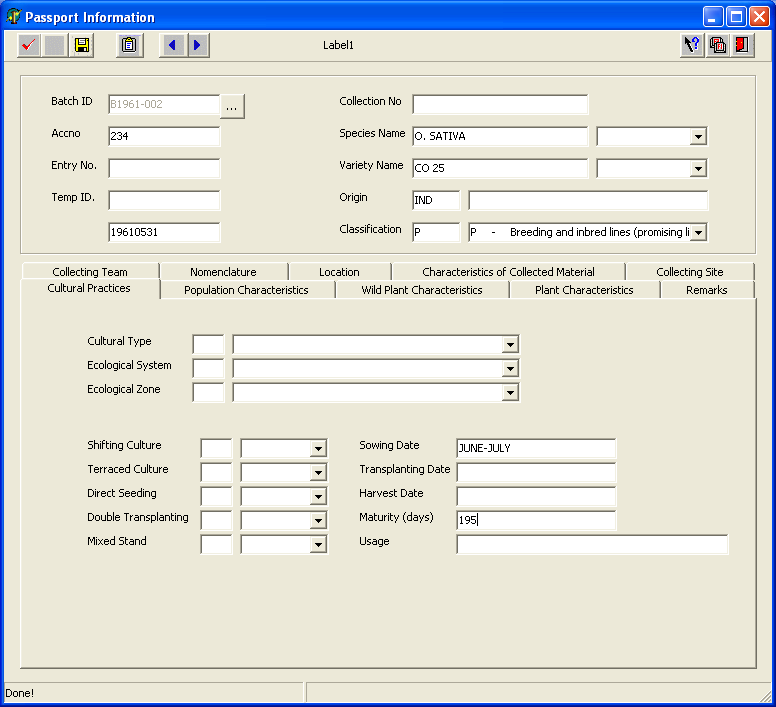
Basic Information
|
|
| Field Name |
Description |
| Batch ID |
Identification code assigned to a batch. |
| Entry No |
Entry number assigned to a sample. |
| Temp ID |
Unique temporary identification number generated for every sample. |
| Collection No |
Number or code assigned by the collecting team to the sample gathered. |
| Species Name |
Specie name of the sample.
|
| Variety Name |
Local/vernacular name of the sample. |
| Origin |
Country of origin of the sample. |
Collecting Team
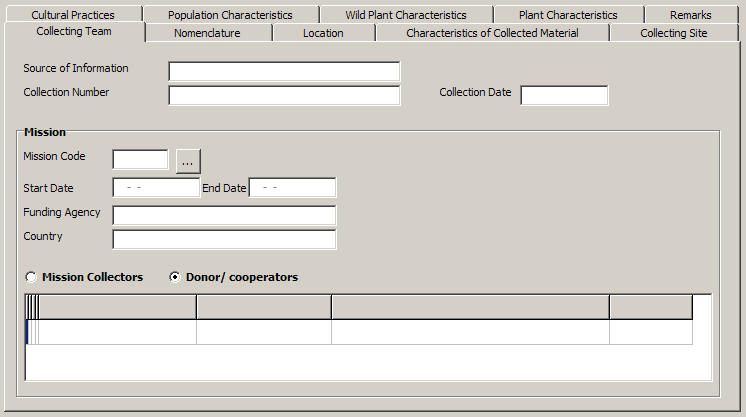
|
|
| Field Name |
Description |
| Source of Information |
Refers to the person or publication where the passport information was obtained. |
| Collection No |
Number or code assigned by the collecting team to the sample gathered. |
| Collection Date |
Date sample was collected. |
| Mission Code |
GRIMS assigned code to the mision
|
| Start Date |
Date the mission started. |
| End Date |
Date the mission ended. |
| Funding Institute |
Institutethat funded the collecting mission. |
| Cooperators |
Names of the donor/ cooperators who participated in the collection of seed sample. |
Nomenclature

|
|
| Field Name |
Description |
| Language of Variety Name |
Language/dialect of the varietal name or vernacular name of wild species. |
| Meaning of Variety Name |
Translation of the vernacular name into English. |
Location
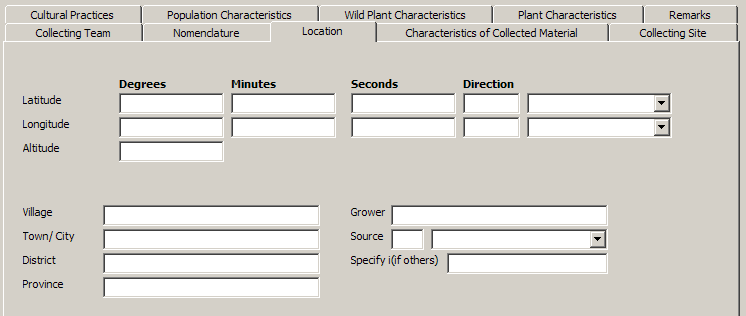
|
|
| Field Name |
Description |
| Latitude |
Latitude is the angular distance north or south from the earth's equator. Format : degree.minute.second.direction |
| Longitude |
Longitude is the arc of the earth's equator
intersected between the meridian of a given place and the prime meridian. Format : degree.minute.second.direction |
| Altitude (m) |
Elevation above sea level in meters. |
| Village |
Village where sample was collected. |
| Town/city |
Town or city where sample was collected. |
| District |
District where sample was collected. |
| Province |
Province where sample was collected. |
| Grower |
Name of farmer or grower of the sample collected. |
| Source |
Type of source location of the germplasm [i.e. farmland, threshing floor, farm store, market, institute, field border, wild] |
| Specify (if others) |
Specify source not in the list. |
Characteristics of Material Collected
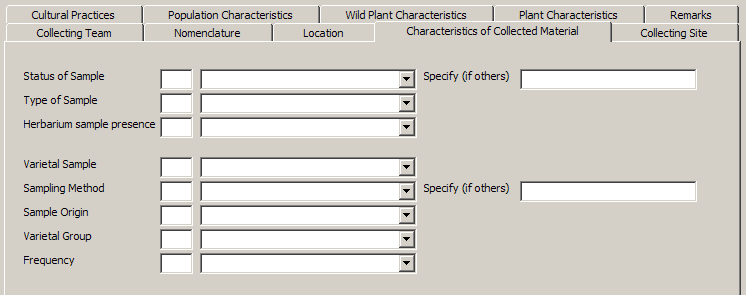
|
|
| Field Name |
Description |
| Status of Sample |
Type of germplasm collected [i.e. wild, weedy, primitive cultivar] |
| Type of Sample |
Plant parts collected [i.e seeds, panicle, vegetative] |
| Herbarium Sample Presence |
Indicates whether an herbarium sample was taken on the sample or not. |
| Specify (if others) |
Mention other characteristics observed. |
| Varietal sample |
Describes the composition of the variety collected [i.e. single variety, varietal mixture] |
| Sampling method |
Indicates how the collected material were sampled [i.e. random, non-random] |
| Sample origin |
Indicates whether a sample is indigenous or introduced to the area where it was collected [i.e. local, exotic]. |
| Variety group |
Classification of accessions into variety groups is based mainly on the
morphologic features of the adult plant, and to a certain extent, on grain appearance [i.e. indica, japonica, javanica, hybrids]. |
| Frequency |
Frequency of occurrence of species/variety collected in an area [i.e. abundant, frequent, occasional, rare] |
| Specify (if others) |
Mention other characteristics of the materials observed. |
Characteristics of Collecting Site

|
|
| Field Name |
Description |
| Topography |
Configuration of a surface including its relief and the position of its natural and man-made features [i.e. swamp, flood plain, plain level, undulating, hilly, mountainous] |
| Site |
Topographical condition of a specific area where sample was collected [i.e. level, slope, summit, depression] |
| Soil texture |
Relative proportions of sand, silt and clay in a sample [sand, loam, clay, silt, highly organic] |
| Drainage |
Manner in which the waters pass off the surface of the land [i.e. poor, moderate, good, excessive] |
| Shading |
Refers to the amount of exposure to the sun of the plant where sample was collected. Applicable for wild species [i.e. open, partial shade, complete shade]. |
| Specify (if others) |
Mention other characteristics of the collecting site. |
Practices associated with materials
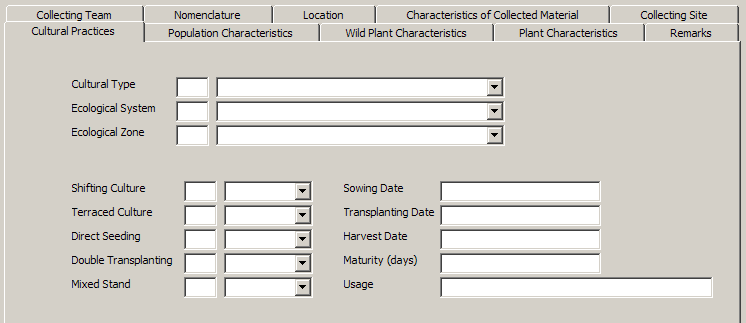
|
|
| Field Name |
Description |
| Cultural type |
Rice ecosystem. |
| Eco. system |
Refers to the environment where the sample was collected [i.e. dryland hydromorphic, shallow flooded swamp, deep flooded swamp, floating rice, mangrove, irrigation] |
| Eco. zone |
Refers to the edaphic-climatic condition of the area [i.e. forest, transition zone, derived savanna, guinea savanna, sudan savanna, sahel, montane]. |
| Shifting culture |
Cultural practice [Y if yes and N otherwise]. |
| Terraced culture |
Cultural practice [Y if yes and N otherwise]. |
| Direct seeding |
Cultural practice [Y if yes and N otherwise]. |
| Double transplanting |
Cultural practice [Y if yes and N otherwise]. |
| Mixed stand |
Cultural practice [Y if yes and N otherwise]. |
| Sowing date |
Date sample was sown. |
| Transplanting Date |
Date sample was transplanted. |
| Harvest date |
Date variety was harvested. |
| Maturity (days) |
Maturity is estimated at 30 days after full heading. Observed in cultivated species. |
| Usage |
Usage of variety collected. |
Population Characteristics
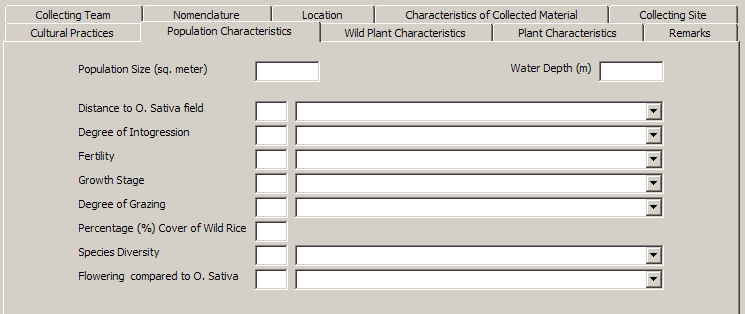
|
|
| Field Name |
Description |
| Population size (m2) |
Population size in square meters, estimated visually at collection site. |
| Water depth (m) |
Approximate depth of water where sample was collected. |
| Distance to O. Sativa field |
Distance of collection site of wild species to the nearest O. sativa field. |
| Degree of introgression |
Spread of genes of one species into the gene complex of another. |
| Fertility |
General seed set in a population per unit area. |
| Growth stage |
Growth stage of plant sampled during collection time [i.e. vegetative, flowering, mature, seed shed]. |
| Degree of grazing |
A disturbance factor which refers to the extent of grazed area observed at the collection site. |
| % Cover of wild rice |
% coverage (area) of wild rice at collecting site, estimated to the nearest 5%. |
| Species diversity |
Approximate number of species in the collection site. |
| Flowering compared to O. Sativa |
Time of flowering of collected wild species sample compared to O. sativa. |
Plant Characteristics (p1)
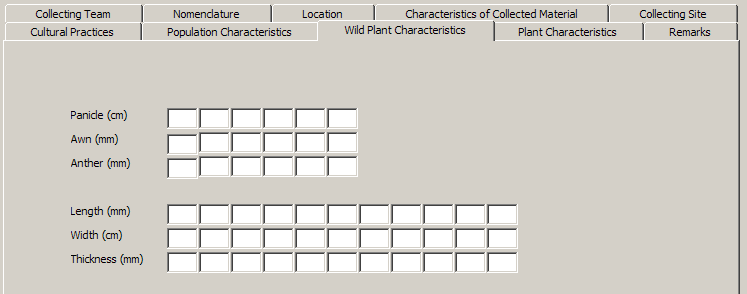
|
|
| Field Name |
Description |
| Length of Panicle (cm) |
Length of panicles (n=5) is measured in cm from the base to the tip of the panicle. |
| Length of Awn (mm) |
Awn is a bristle-like extension of varying lengths originating from the lemma of the grain. Length is measured in mm and done at anthesis (n=5). |
| Length of Anther (mm) |
Anther is the sac of the stamen of the seed plants that contains the pollen. Length is measured in mm at anthesis (n=5). |
| Length of Grain (mm) |
Grain length (n=10) is measured in mm as the distance from the base of the lowermost sterile lemma to the tip (apiculus) of the fertile lemma or palea, which ever is longer. |
| Width of Grain (mm) |
Grain width is measured (n=10) in mm as the distance across the fertile lemma and the palea at the widest point. |
| Thickness of Grain (mm) |
Grain thickness is the lateral diameter (mm) measured from 10 grains as the largest distance between the two lateral sides in the middle part of the caryopsis. |
Plant Characteristics (p2)
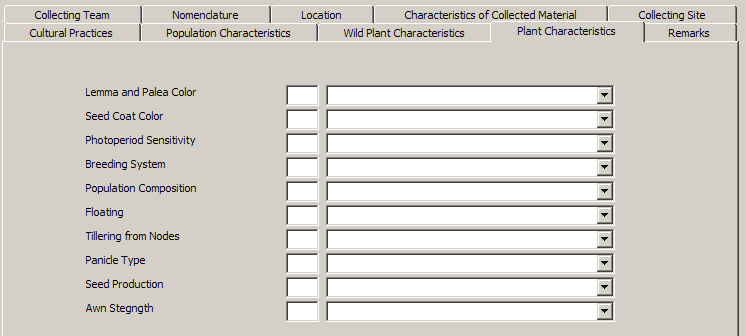
|
|
| Field Name |
Description |
| Lemma and palea color |
Lemma is the five-nerved and outer bract of the floret. Palea is the three-nerved bract of the floret which fits the lemma. Color is examined at anthesis. |
| Seed Coat Color |
Seed coat color is the color of dehulled grains. Examined at post-harvest. |
| Photoperiod sensitivity |
Photoperiod is the relative lengths of alternating periods of lightness and darkness as they affect the growth and maturity of an organism. |
| Breeding System |
Method of reproduction [i.e. inbreeding, outcrossing, vegetative, unsure, mixture] |
| Population composition |
The degree of homogeneity or heterogeneity of the sample. |
| Floating |
Water-borne. |
| Tillering from nodes |
Tiller count is recorded as the total number of grain-bearing and non-bearing tillers per hill. |
| Panicle type |
Panicles are classified according to their mode of branching, angle of primary branches and spikelet density. |
| Seed production |
Low or High seed production. |
| Awn strength |
Awn is a bristle-like extension of varying lengths wild originating from the lemma of the grain [i.e. soft, hard, intermediate]. |
Remarks

|
|
| Field Name |
Description |
| Grain Characteristics |
Grain characteristics as observed by the collector. |
| Plant Characteristics |
Plant characteristics as observed by the collector. |
| Pests/diseases |
Resistance to pests/diseases. |
| Other Observation |
Other observations on the sample collected. |
| Special Types |
Special characteristics of the sample collected. |
Interactive user interface elements
| icon
| action
|

| Query record
|

| Clear function
|

| Save function
|

| Previous record
|

| Next record
|

| Help function
|

| Hot keys display
|

| Close form
|

| Look up table
|
Use Case Definition
| Use Case Name
| 1.4.0 Enter Passport Information
|
| Use Case Definition
| The use case allows data entry of passport information. Data are stored both in a serialized format( ICIS Germplasm attributes) and in parallel format (normal table with descriptors as column name).
|
| User Contacts
|
|
| Actors
| Genebank Technician (GBT)
|
| Location
| GRC Data Management
|
| Priority
| 1
|
| Typical Course of Events
|
| Actor Action
| System Response
|
| Step1. GBT selects a batch of incoming samples.
| Step2. System retrieves the seed list.
|
| Step3. GBT inputs passport information
| Step4. System stores the information in the database
|
|
| Assumption/s
| The seed list has been inputed to the system
|
| Pre-condition/s
|
|
| Post-condition/s
| Passport data is stored
|
| Primary Pathway/s
| Enter passport data
|
| Alternative Pathway/s
| Enter passport data through ICIS SetGen
|
| Exception Pathway/s
|
|












